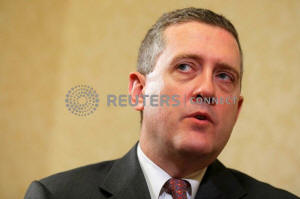Fed in three voices: recession, bubbles, and 'in a good place'
 Send a link to a friend
Send a link to a friend
 [September 21, 2019] By
Howard Schneider and Ann Saphir [September 21, 2019] By
Howard Schneider and Ann Saphir
(Reuters) - After delivering a
split-decision rate cut earlier this week, U.S. Federal Reserve
officials put their divisions on full display Friday, with warnings of a
slowdown on the one hand and financial risks on the other bookending
talk of how well things are going.
Central bankers are often called on to speak with one voice, but the Fed
now has three - those ready to reduce rates even lower to ward off
economic risks, those who prefer to stand pat and watch the data for
now, and those warning that the Fed may already be fueling a credit
bubble.
"The economy is in a good place," Fed Vice Chair Richard Clarida said in
a CNBC interview, noting that while there are risks, there is also a
"virtuous circle" under way of job gains, wage gains, and increased
spending among households.
Consumption accounts for nearly 70% of the U.S. economy, and "I cannot
think of a time in aggregate when the consumer has been in better
shape," Clarida said.
Fed policymakers voted 7-3 to reduce their target overnight policy rate
by a quarter of a percentage point on Wednesday, to a level of between
1.75% and 2.0%. It was the second Fed rate reduction this year.

The move, which Clarida supported, was aimed at offsetting slowing
global growth and risks associated with U.S. President Donald Trump's
trade battles with China.
But, as the first Fed decision since 2016 to draw three dissents, it's
clear there was a split. A range of views at the U.S. central bank is
not unusual with 17 policymakers around the table, 10 of whom get to
vote on rates at any given meeting.
What's unusual now is the crisp division and the reasons driving it, all
against the political context of a president who wants deep rate cuts
for a wholly different rationale.
Trump, facing reelection next year, has lashed out at Fed policymakers
with an array of sometimes personal insults, most recently calling them
'boneheads' and suggesting Chair Jerome Powell was an enemy of the state
for not heeding his demands.
For Trump, who argues the U.S. economy is the strongest ever, the logic
is simple: cut rates to make it even stronger, with little or no risk
because inflation is so low.
But even those who agree with lower rates see the situation differently,
with St. Louis Fed President James Bullard arguing that the Fed should
have cut deeper this week to ward off weakness that includes a
manufacturing sector which "already appears to be in recession."
At the other end of the spectrum was Boston Federal Reserve President
Eric Rosengren. "Additional monetary stimulus is not needed for an
economy where labor markets are already tight," Rosengren wrote in a
note explaining his own dissent from the Fed's rate cut.
[to top of second column] |

James Bullard, President of the St. Louis Federal Reserve Bank,
speaks during an interview with Reuters in Boston, Massachusetts
August 2, 2013. REUTERS/Brian Snyder/File Photo

In a challenge to Trump's view that low rates are costless to the economy,
Rosengren said current Fed policy is now actively nudging people to borrow and
"risks further inflating the prices of risky assets and encouraging households
and firms to take on too much leverage."
Not so, Dallas Fed President Robert Kaplan told reporters after an event in
Corpus Christi, Texas. Cutting rates in July and September, he said, "will
improve the growth outlook and it may make it in fact less likely that there are
incentives for people to borrow and leverage and take risk – they may still do
it, but it won’t be because rates are lower."
Kaplan, who didn't vote on the rate cut but argued in favor of it, said he has
penciled in no further rate cuts this year, and just one next year.
SHIFTING SANDS
This week's rate cut followed an even larger shift in the Fed's policy outlook
since late last year, when many officials expected they would still be raising
rates through 2019.
Global growth and global bond markets started pushing in the other direction,
however, opening a wide gap last spring and summer between the Fed's policy
projections and what investors anticipated would happen.
As a result of the change in rates and updated economic views, that gap has
narrowed substantially, a positive development for a central bank whose top
officials are being careful now not to flag what their next move might be until
there is more information about the economy's underlying health and direction.
After a spate of negative news over the summer, recent data has included
positive surprises, including stronger-than-expected home sales, stock markets
approaching new records, and a restart of U.S.-China trade talks - a counter to
Bullard's more dire view.
Officials' projections issued last week show the 17 Fed members split into
roughly equal groups, with seven projecting one more rate reduction this year,
five seeing no change, and five expecting that a rate hike will be appropriate
by the end of the year.
The projections are issued anonymously, and while on Friday Kaplan revealed his
views, it remains unclear where other influential officials, and most
importantly Powell and Clarida, fit in that mix.
In his remarks Clarida hewed close to the language Powell used in a Wednesday
press conference, saying the Fed would "act as appropriate," and watch incoming
economic data for decisions that will be made "meeting by meeting."
(Reporting by Howard Schneider and Linsday Dunsmuir in Washington, Jonnelle
Marte in New York and Ann Saphir in Corpus Christi; Editing by Nick Zieminski
and Andrea Ricci)
[© 2019 Thomson Reuters. All rights
reserved.] Copyright 2019 Reuters. All rights reserved. This material may not be published,
broadcast, rewritten or redistributed.
Thompson Reuters is solely responsible for this content. |